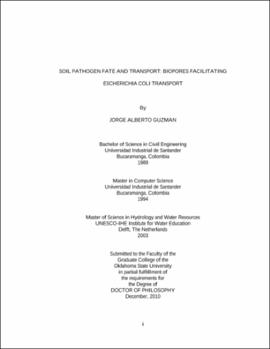| dc.contributor.advisor | Fox, Garey A. | |
| dc.contributor.author | Guzman, Jorge Alberto | |
| dc.date.accessioned | 2013-11-26T07:43:14Z | |
| dc.date.available | 2013-11-26T07:43:14Z | |
| dc.date.issued | 2010-12 | |
| dc.identifier.uri | https://hdl.handle.net/11244/6409 | |
| dc.description.abstract | Scope and Method of Study: Laboratory and field experiments, and computational model. | |
| dc.description.abstract | Findings and Conclusions: Following manure application, rapid transport of fecal bacteria in runoff and infiltration may result in fecal bacteria contamination of deeper soils and adjacent water bodies. Fecal microorganisms are a group of virus, bacteria and protozoa commonly not pathogenic. Investigations for fecal soil and water contamination, and fate and transport are typically conducted using indicator organisms such as Escherichia coli and Enterococcus faecalis. Fecal bacteria fate and transport in soils treated with manure effluent are driven by multiple interrelated physical, chemical and biological processes. This research investigated the significance of biopores in facilitating fecal bacteria transport to deeper soils and subsurface drainage systems and incorporated fecal bacteria fate and transport routines and a biopore concept in the Root Zone Water Quality Model (RZWQM). In most cases, the soil matrix can retard, immobilize and/or inactivate fecal bacteria being transported. However, facilitated flow and fecal bacteria transport through macropores and biopores allow fecal bacteria to rapidly bypass a portion of the soil matrix and reach deeper soils and subsurface drainage systems as a function of the soil type and the presence of macropores from soil structure or cracks. Also, manure effluent constituents can potentially change the soil bulk solution pH and favor ionic exchange resulting in varying soil-bacteria or soil bacteria-substrate sorption mechanisms. Fecal bacteria die-off rates vary as a function of lag time between manure application and the occurrence of rainfall or irrigation events, and environmental variables. New routines implemented into RZWQM allow fecal bacteria fate and transport simulation in the soil matrix, runoff, soil profile, and drainage system. Moreover, the implemented biopore concept allows RZWQM to simulate non-equilibrium flow conditions. In combination with the macropore model available in RZWQM, the implemented biopore concept improved flow and fecal bacteria transport simulations at the drain pipe, in runoff and through the soil profile and therefore may be useful when assessing fecal bacteria contamination of soil and water and helping to address mitigation and regulatory strategies. | |
| dc.format | application/pdf | |
| dc.language | en_US | |
| dc.rights | Copyright is held by the author who has granted the Oklahoma State University Library the non-exclusive right to share this material in its institutional repository. Contact Digital Library Services at lib-dls@okstate.edu or 405-744-9161 for the permission policy on the use, reproduction or distribution of this material. | |
| dc.title | Soil pathogen fate and transport: Biopores facilitating Escherichia coli transport | |
| dc.contributor.committeeMember | Brown, Glenn O. | |
| dc.contributor.committeeMember | Storm, Daniel E. | |
| dc.contributor.committeeMember | Penn, Chad J. | |
| osu.filename | Guzman_okstate_0664D_11232 | |
| osu.accesstype | Open Access | |
| dc.type.genre | Dissertation | |
| dc.type.material | Text | |
| thesis.degree.discipline | Biosystems and Agricultural Engineering | |
| thesis.degree.grantor | Oklahoma State University | |
